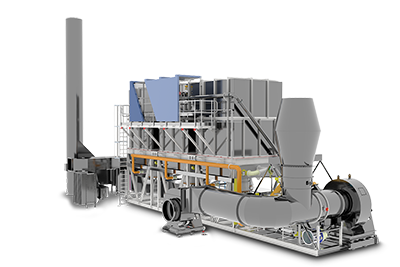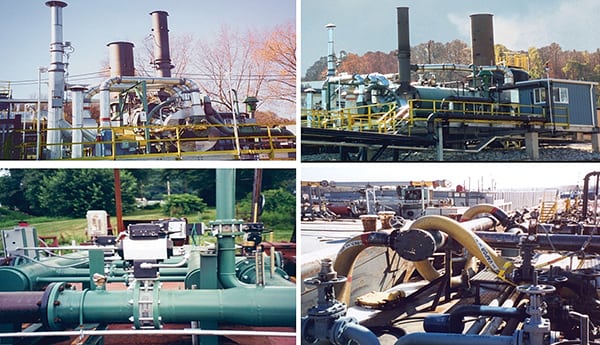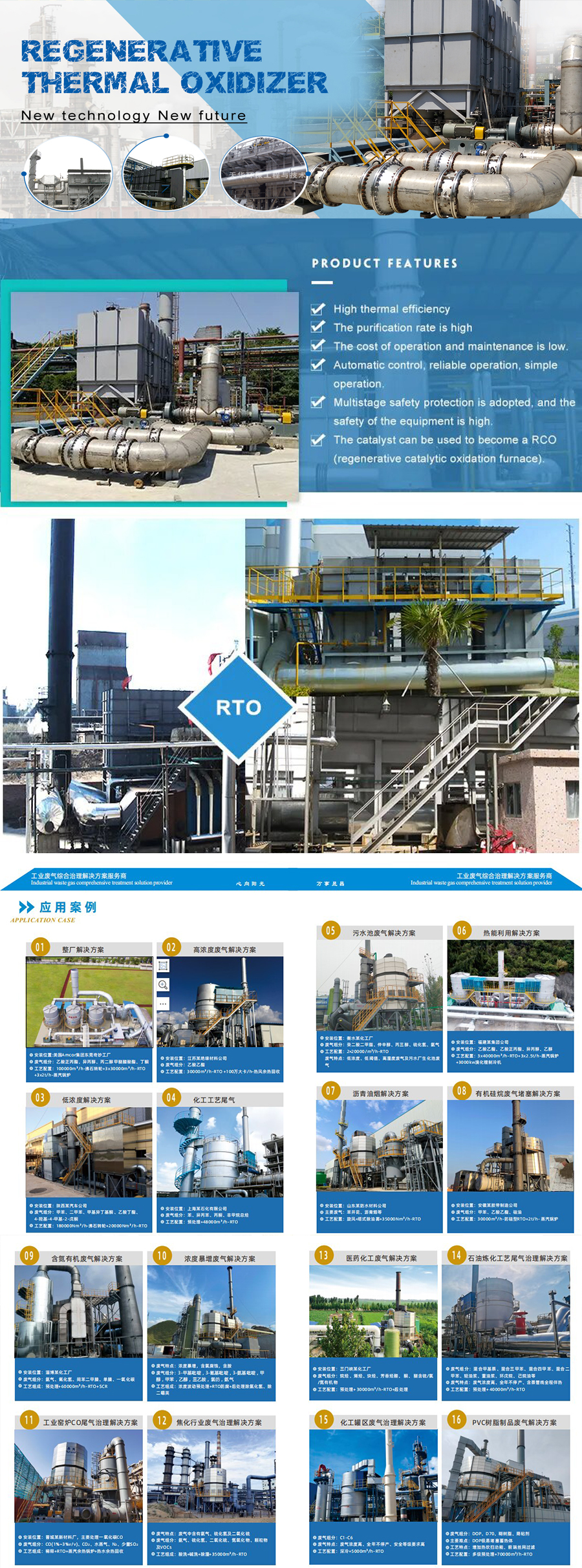基本訊息
型號
Amazing RTO
類型
Incinerator
High Efficiency
100
Energy Saving
100
Low Maintenance
100
Easy Operation
100
商標
Bjamazing
運輸套餐
Overseas
Specification
111
起源
China
HS Code
2221111
產品描述
RTO
蓄熱式熱氧化器
Compared with traditional catalytic combustion,; direct thermal oxidizer,; RTO has the merits of high heating efficiency,; low operation cost,; and the ability to treat large flux low concentration waste gas.; When VOCs concentration is high,; secondary heat recycle can be realized,; which will greatly reduce the operation cost.; Because RTO can preheat the waste gas by levels through ceramic heat accumulator,; which could make the waste gas to be completely heated and cracked with no dead corner(treatment efficiency>99%);,;which reduce the NOX in the Exhausting gas,; if the VOC density >1500mg/Nm3,; when the waste gas reach cracking area,; it has been heated up to cracking temperature by heat accumulator,; the burner will be closed under this condition.;
RTO can be devided into chamber type and rotary type according to difference operation mode.; Rotary type RTO has advantages in system pressure,; temperature stability,; investment amount,; etc
| RTO types | Efficiency | Pressure change (mmAq); | 尺寸 | (max);Treatment volume | |
| Treatment efficiency | Heat recycle efficiency | ||||
| Rotary type RTO | 99 % | 97 % | 0-4 | small (1 time); | 50000Nm3/h |
| Three chamber type RTO | 99 % | 97 % | 0-10 | Large (1.;5times); | 100000Nm3/h |
| Two chamber type RTO | 95 % | 95 % | 0-20 | middle (1.;2times); | 100000Nm3/h |
Regenerative Thermal Oxidizer,; Regenerative Thermal Oxidizer,; Regenerative Thermal Oxidizer,; Thermal Oxidizer,; Thermal Oxidizer,; Thermal Oxidizer,; oxidizer,; oxidizer,; oxidizer,; incinerator,; incinerator,; incinerator,; waste gas treatment,; waste gas treatment,; waste gas treatment,; VOC treatment,; VOC treatment,; VOC treatment,; RTO,; RTO,; RTO,; Rotary RTO,; Rotary RTO,; Rotary RTO,; Chamber RTO,; Chamber RTO,; Chamber RTO
Address: 8 floor, E1, Pinwei building, Dishengxi road, Yizhuang, ZheJiang , China
業務類型: 製造商/工廠, 貿易公司
Business Range: Electrical & Electronics, Industrial Equipment & Components, Manufacturing & Processing Machinery, Metallurgy, Mineral & Energy
Management System Certification: ISO 9001, ISO 14001
Main Products: Rto, Color Coating Line, Galvanizing Line, Air Knife, Spares for Processing Line, Coater, Independent Equipments, Sink Roll, Revamping Project, Blower
Company Introduction: ZheJiang Amazing Science & Technology Co., Ltd is a thriving Hi-tech company, located in ZheJiang Economic and Technological Development Area(BDA). Adhering to the concept of Realistic, Innovative, Focused and Efficient, our company mainly serve the waste gas treatment (VOCs) Industry and metallurgical equipment of China and even whole world. We have advanced technology and rich experience in VOCs waste gas treatment project, the reference of which has been successfully applied to the industry of coating, rubber, electronic, printing, etc. We also have years of technology accumulation in the research and manufacturing of flat steel processing line, and possess nearly 100 of application example.
Our company focus on the research, design, manufacturing, installation and commissioning of VOCs organic waste gas treatment system and the revamping and updating project for energy saving and environmental protection of flat steel processing line. We can provide customers the complete solutions for environmental protection, energy saving, product quality improvement and other aspects.
We are also engaged in various spares and independent equipment for color coating line, galvanizing line, pickling line, like roller, coupler, heat exchanger, recuperator, air knife, blower, welder, tension leveler, skin pass, expansion joint, shear, jointer, stitcher, burner, radiant tube, gear motor, reducer, etc.

蓄熱式熱氧化器與催化氧化器相比如何?
蓄熱式熱氧化器 (RTO) 和催化氧化器都是用來控制工業製程空氣排放的有效技術。雖然它們的用途相似,但在操作、效率和適用性方面存在顯著差異。
以下是 RTO 和催化氧化劑之間的比較:
| 蓄熱式熱氧化器 (RTO) | 催化氧化劑 |
|---|---|
| 手術: | 手術: |
| RTO 透過高溫燃燒實現排放控制,無需使用催化劑。它們依賴熱氧化過程,其中廢氣中的 VOC 和其他污染物在高溫(通常在 1,400°F 至 1,600°F 之間)和過量氧氣存在的情況下被氧化。 | 與 RTO 相比,催化氧化劑利用催化劑(通常是貴金屬,例如鉑、鈀或銠)來促進 VOC 和其他污染物在較低溫度下的氧化。此催化劑降低了氧化反應所需的活化能,使其能夠在較低溫度(約 600°F 至 900°F)下發生。 |
| 效率: | 效率: |
| RTO 以其高熱效率而聞名。他們利用再生式熱交換器系統,將熱量從處理後的廢氣中回收並傳遞到進入的未處理氣體中,從而顯著降低燃料消耗。這種熱回收機制使 RTO 更加節能。 | 催化氧化器通常比 RTO 更節能,因為它們在較低的溫度下運作。催化劑促進氧化反應,使其在較低溫度下發生,從而減少加熱廢氣的能量需求。 |
| 適用性: | 適用性: |
| RTO 特別適合污染物濃度高或流量或污染物濃度變化較大的應用。它們通常用於控制化學製造、印刷、塗料和製藥等各行業的揮發性有機化合物 (VOC) 和有害空氣污染物 (HAP)。 | 在污染物濃度相對較低且相對恆定的應用中,通常優選催化氧化劑。它們對於汽車噴漆、印刷和食品加工等應用中的 VOC 控制非常有效,這些應用中 VOC 濃度可以更低且更一致。 |
| 限制: | 限制: |
| 由於其複雜的設計和熱回收系統,RTO 與催化氧化器相比具有更高的資本成本。它們還具有較高的工作溫度,這可能會限制它們在某些製程中的適用性或需要額外的熱回收系統。 | 催化氧化劑可能對廢氣中的毒物或污染物敏感,這些毒物或污染物會隨著時間的推移而使催化劑失去活性或降解。某些化合物,例如硫、有機矽或鹵代化合物,可能會毒害催化劑,降低其有效性並需要定期更換或再生催化劑。 |
在 RTO 和催化氧化器之間進行選擇時,必須考慮應用的特定要求,包括污染物濃度、流速、溫度要求和成本考量。諮詢環境工程專業人士或設備製造商可以協助確定最適合特定排放控制需求的技術。

Can regenerative thermal oxidizers be used for treating emissions from wood processing operations?
Yes, regenerative thermal oxidizers (RTOs) can be used effectively for treating emissions from wood processing operations. Wood processing operations, such as sawmills, veneer production, and wood product manufacturing, can generate various pollutants, including volatile organic compounds (VOCs) and hazardous air pollutants (HAPs). Here are some key points regarding the use of RTOs for treating emissions from wood processing operations:
- Emission Control: RTOs are designed to achieve high destruction efficiencies for VOCs and HAPs. These pollutants are oxidized within the RTO at high temperatures, typically above 95% efficiency, converting them into carbon dioxide (CO2) and water vapor. This ensures effective control and reduction of emissions from wood processing operations.
- Process Compatibility: RTOs can be integrated into the exhaust systems of various wood processing operations, capturing and treating the emissions before they are released into the atmosphere. The RTO is typically connected to the process equipment or exhaust stack, allowing the VOC-laden air to pass through the oxidizer for treatment.
- Flexibility: RTOs offer flexibility in handling a wide range of operating conditions and pollutants. Wood processing operations can vary in terms of flow rates, temperature, and composition of emissions. RTOs are designed to accommodate these variations and provide effective treatment even under fluctuating conditions.
- Particulate Removal: Wood processing operations may also generate particulate matter, such as wood dust or sawdust. While RTOs are primarily designed for treating gaseous pollutants, they can be complemented with additional particulate control devices, such as cyclones or fabric filters, to address particulate emissions and ensure compliance with air quality standards.
- 熱回收: RTOs incorporate heat exchange systems that allow for the recovery and reuse of thermal energy. The heat exchangers within the RTO capture the heat from the outgoing exhaust gases and transfer it to the incoming process air or gas stream. This heat recovery process improves the overall energy efficiency of the system and reduces the need for additional fuel consumption.
- Compliance with Regulations: Wood processing operations are subject to regulatory requirements for air quality and emissions control. RTOs are capable of achieving the necessary destruction efficiencies and can help wood processors comply with environmental regulations. The use of RTOs demonstrates a commitment to sustainable practices and responsible management of air emissions.
It is important to note that the specific design and configuration of the RTO, as well as the characteristics of the wood processing emissions, should be considered when implementing an RTO for a specific application. Consulting with experienced engineers or RTO manufacturers can provide valuable insights into the proper sizing, integration, and performance requirements for treating emissions from wood processing operations.
In summary, RTOs are a suitable and effective technology for treating emissions from wood processing operations, providing high destruction efficiencies, compatibility with various processes, flexibility in handling operating conditions, potential for particulate removal, heat recovery, and compliance with environmental regulations.

How do regenerative thermal oxidizers compare to other air pollution control devices?
Regenerative thermal oxidizers (RTOs) are highly regarded air pollution control devices that offer several advantages over other commonly used air pollution control technologies. Here’s a comparison of RTOs with some other air pollution control devices:
| Comparison | 蓄熱式熱氧化器 (RTO) | Electrostatic Precipitators (ESPs) | Scrubbers |
|---|---|---|---|
| Efficiency | RTOs achieve high VOC destruction efficiency, typically exceeding 99%. They are highly effective in destroying volatile organic compounds (VOCs) and hazardous air pollutants (HAPs). | ESPs are effective in collecting particulate matter, such as dust and smoke, but they are less effective in destroying VOCs and HAPs. | Scrubbers are efficient in removing certain pollutants, such as gases and particulate matter, but their performance may vary depending on the specific pollutants being targeted. |
| 適用性 | RTOs are suitable for a wide range of industries and applications, including high-volume exhaust gases. They can handle varying concentrations and types of pollutants. | ESPs are commonly used for particulate matter control in applications such as power plants, cement kilns, and steel mills. They are less suitable for VOC and HAP control. | Scrubbers are widely used for removing acid gases, such as sulfur dioxide (SO2) and hydrogen chloride (HCl), as well as certain odorous compounds. They are often employed in industries such as chemical manufacturing and wastewater treatment. |
| Energy Efficiency | RTOs incorporate heat recovery systems that allow for significant energy savings. They can achieve high thermal efficiency by preheating the incoming process air using the heat from the outgoing exhaust stream. | ESPs consume relatively low energy compared to other technologies, but they do not offer heat recovery capabilities. | Scrubbers generally consume more energy compared to RTOs and ESPs due to the energy required for liquid atomization and pumping. However, some scrubber designs may incorporate heat recovery mechanisms. |
| Space Requirements | RTOs typically require more space compared to ESPs and certain scrubber designs due to the need for ceramic media beds and larger combustion chambers. | ESPs have a compact design and require less space compared to RTOs and some scrubber configurations. | Scrubber designs vary in size and complexity. Certain scrubber types, such as packed bed scrubbers, may require a larger footprint compared to RTOs and ESPs. |
| 維護 | RTOs generally require regular maintenance of components such as valves, dampers, and ceramic media beds. Periodic media replacement may be necessary depending on the operating conditions. | ESPs require periodic cleaning of collection plates and electrodes. Maintenance activities involve the removal of accumulated particulate matter. | Scrubbers require maintenance of liquid circulation systems, pumps, and mist eliminators. Regular monitoring and adjustment of the chemical reagents used in the scrubbing process are also necessary. |
It’s important to note that the selection of an air pollution control device depends on the specific pollutants, process conditions, regulatory requirements, and economic considerations of the industrial application. Each technology has its own advantages and limitations, and it’s essential to evaluate these factors to determine the most appropriate solution for effective air pollution control.

editor by Dream 2024-12-30
